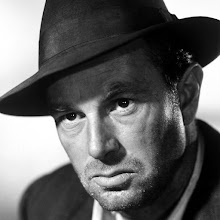Despre manierele subtile in care un film difera de altul. Despre nevazutele din film, pentru ca sint prea vazute, pentru ca le luam de-a gata, taken from granted, pentru ca de cele mai multe ori nici nu ne dam seama de atotprezenta lor si de cit de mult conteaza in a face distinctia, in a crea specificul stilului.
De pe blogul lui David Bordwell despre cinema. Un articol fain, din care imi permit sa copiez copios :)
* * *
In the late 1940s and early 1950s, André Bazin, one of the great theorists and critics of cinema, argued that Orson Welles and William Wyler created a sort of revolution in filmmaking. They staged a shot’s action in several planes, some quite close to the camera, and maintained more or less sharp focus in all of them. Bazin claimed that Welles’ Citizen Kane and The Magnificent Ambersons and Wyler’s The Little Foxes and The Best Years of Our Lives constituted “a dialectical step forward in film language.”
Their “deep-focus” style, he claimed, produced a more profound realism than had been seen before because they respected the integrity of physical space and time. According to Bazin, traditional cutting breaks the world into bits, a series of close-ups and long shots. But Welles and Wyler give us the world as a seamless whole. The scene unfolds in all its actual duration and depth. Moreover, their style captured the way we see the world; given deep compositions, we must choose what to look at, foreground or background, just as we must choose in reality. Bazin wrote of Wyler:
Thanks to depth of field, at times augmented by action taking place simultaneously on several plane, the viewer is at least given the opportunity in the end to edit the scene himself, to select the aspects of it to which he will attend.
While granting differences between the directors, Bazin said much the same about Welles, whose depth of field “forces the spectator to participate in the meaning of the film by distinguishing the implicit relations” and creates “a psychological realism which brings the spectator back to the real conditions of perception” (7).
In addition, Bazin pointed out, this sort of composition was artistically efficient. The deep shot could supply both a close-up and a long-shot in the same framing—a synthesis of what traditional editing had given in separate shots. Bazin wove all these ideas into a larger theory that cinema was inherently a realistic medium, bound to photographic recording, and Welles and Wyler had discovered one path to artistic expression without violating the medium’s biases.
There are many objections to Bazin’s argument, some of which I’ve rehearsed in On the History of Film Style. My point here is that Bazin was presenting analytical points that stemmed from publicity put out by Welles, Wyler, and especially their talented cinematographer Gregg Toland.
In a 1941 article in American Cinematographer, Toland talked freely about how he sought “realism” in Citizen Kane. The audience must feel it is “looking at reality, rather than merely a movie.” Key to this was avoiding cuts by means of long takes and great depth of field, combining “what would conventionally be made as two separate shots—a close-up and an insert—into a single, non-dollying shot.” Toland defended his sometimes extreme stylistic experimentation on grounds of realism and production efficiency, criteria that carried some weight in his professional community of cinematographers and technicians.
Toland’s campaign for his style addressed the general public too. For Popular Photography he wrote an article explaining again that his “pan-focus” technique captured the conditions of real-life vision, in which everything appears in sharp focus. A still broader audience encountered a Life feature in the same year, explaining Toland’s approach with specially-made illustrations. Two samples show selective focus, one focused on the background, the other on the foreground.
An accompanying photo shows pan-focus at work, with Toland in frame center, an actor in the background, and Toland’s camera assistant in the foreground.
In sum, Toland’s publicity prepared viewers, both professional and nonprofessional, for an odd-looking movie.
Throughout the 1940s, Welles and Wyler wrote and gave more interviews, often insisting that their films invited greater participation on the part of spectators. In a crucial 1947 statement, Wyler noted:
Gregg Toland’s remarkable facility for handling background and foreground action has enabled me over a period of six pictures he has photographed to develop a better technique for staging my scenes. For example, I can have action and reaction in the same shot, without having to cut back and forth from individual cuts of the characters. This makes for smooth continuity, an almost effortless flow of the scene, for much more interesting composition in each shot, and lets the spectator look from one to the other character at his own will, do his own cutting.
Două rapide cu justiția
Acum o oră





5 comentarii:
Rose...bud... X_X. Welles e singurul care a început de sus ca să involueze în restul carierei. Fain!
Enjoy - daca nu cumva ai ascultat-o deja :-)
http://zaffcat.blogspot.com/2010/06/song-around-world.html
Am cumparat astazi, de la Carturesti, doua carti traduse de Cristina Corciovescu - Cinematograful Japonez si Noul val francez. Foarte interesante. Aparute la Editura IBU Publishing.
http://www.cinemagia.ro/stiri/noul-val-francez-deschide-un-must-have-colectia-arta-007-15118/
domnilor, din nefericire 'deep focus'-ul meseriasilor in ale cinematografiei ii corespunde un 'shallow focus' al receptorului de imagini in miscare proiectate pe un ecran alb intr-o incapere la adapostul intunericului...
indraznesc sa spun ca spectatorul 'obisnuit' de cinema e interesat de poveste in mai mare masura decit de aspectele tehnice ale filmarii (si aici e de dezbatut noptii in sir).
in opinia mea de amator iubitor de cinema, capodoperele apar cind viziunea unica a unui regizor, ajutata in primul rind de abilitatea tehnica (camera + lumini) a directorului de imagine intilneste "povestirea". filmele bune sunt povesti frumoase neinspirat proiectate in ritm de 24 cadre pe secunda sau maiestrii artistice/tehnice ce nu si-au intilnit aleasa (povestea). restul e pelicula buna de incendiat elita celui de-al treilea reich. ;P
OFF TOPIC: Spune-mi si mie ce-s alea sondaje Chapel Hill?
http://www.crpe.ro/library/files/crpe_policy_memo_11_ro.pdf
Vorbesc baietii chiar in prima nota de la studiul asta, dar fara sa explice la ce se refera.
Trimiteți un comentariu